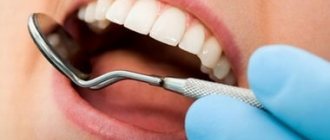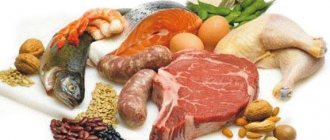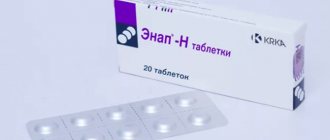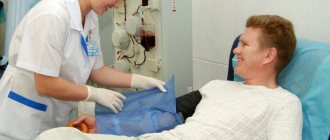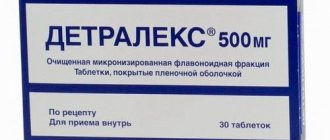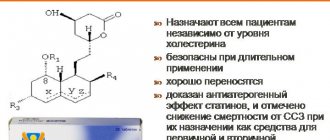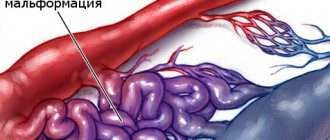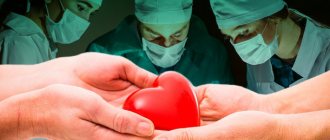Has restrictions during pregnancy
Has restrictions when breastfeeding
Prohibited for children
Has restrictions for older people
Has limitations for liver problems
Has limitations for kidney problems
Relief suppositories are indicated for the treatment of internal forms of hemorrhoids. There are several types of Relief suppositories, differing from each other, but all of them are designed to improve the condition of the final part of the digestive tract (the mucous membrane of the rectum), relieve constipation, and are also used to prevent various diseases. Suppositories can be combined with liniments, using them in one therapeutic complex.
How to use Relief ointment
Before use, hygiene procedures must be carried out.
The product can be used rectally and externally. Children over 12 years of age and adults can use Relief 4 times a day.
The ointment is applied rectally using an applicator. When used externally, the cream treats damaged areas of the anus. After each use, wash the applicator thoroughly and close it with the cap.
Use until symptoms disappear completely. Do not use the medicine if the protective cap is damaged or missing.
Types of suppositories
Today, pharmacies offer 4 types of relief suppositories. When choosing a remedy, you should take into account the symptoms of the disease. It should be understood that successful treatment of hemorrhoids is only possible with an individual approach.
The most commonly prescribed treatment for internal hemorrhoids is classic relief. The components in its composition allow you to quickly stop bleeding and swelling. The main active substance in the classic drug is phenylephrine hydrochloride. It refers to adrenergic stimulants. The component has a local vasoconstrictor effect and improves blood circulation in hemorrhoids. Against this background, the release of exudate decreases and swelling is relieved. Thanks to the cocoa butter content, it has a pronounced softening effect. Due to its mild effect, classic relief is indicated for preventive purposes to prevent exacerbation of the disease. The drug has minimal side effects and can be used for a long time.
Other types of medicinal suppositories:
- Relief Advance. This remedy has a strong analgesic effect. The main active ingredient in the drug is benzocaine, which is a strong anesthetic. Suppositories are recommended for use in the acute stage of the disease, strangulation of the node, as well as after operations or during painful diagnostic procedures. The drug has a number of serious contraindications and can cause negative reactions in the body, so it should only be used if recommended by a doctor.
- Relief Ultra. The active ingredients in the product are zinc sulfate and hydrocortisone acetate. This combination provides a strong anti-inflammatory effect and allows you to quickly relieve itching. The product is an emergency aid for anal fissures. In the postoperative period, suppositories help prevent the development of the inflammatory process. It is allowed to use the product in short courses - up to 7 days. It is important to exclude the presence of contraindications before use.
- Relief Pro. The drug contains fluocortolone pivalate. This substance blocks the production of inflammatory mediators. The pronounced analgesic effect of suppositories is provided by lidocaine. The product is recommended for chronic pathologies that are accompanied by constant pain and inflammation. Due to the large number of side effects, the drug can only be used if indicated and recommended by a doctor.
How to use Relief candles
Before using candles, it is necessary to carry out hygiene procedures.
It is necessary to enter 1 piece. up to 4 times a day (including before bedtime).
Suppositories are best administered in the morning, at night and after each bowel movement. The therapeutic course lasts on average 1-2 weeks.
With regular use, you can achieve a lasting therapeutic result and eliminate the symptoms of the disease.
Do not use the product if the protective coating is damaged or lost.
Therapy rules
You must wash your hands before use. Suppositories are administered rectally after completion of the hygiene procedure, no more than three times a day. Before use, the candle should be heated in your hand until softened. This will help to painlessly insert it into the anus. The course of therapy lasts one to two weeks.
Clinical studies have shown good tolerance of the drug by patients. However, rare cases are characterized by adverse reactions caused by the action of phenylephrine hydrochloride. Adverse reactions are expressed by the following symptoms:
Reflex bradycardia.- Hyperthyroidism.
- Local allergic reactions.
- Contact dermatitis.
- Dizziness, increased excitability of the nervous system, involuntary trembling of the fingers, a feeling of unreasonable fear.
Preservatives - methyl and propyl ether can provoke delayed allergic reactions and bronchospasm.
Concomitant use with antihypertensive drugs is prohibited. The opposite threatens severe hypertension. Atropine sulfate causes vasoconstriction, beta-blockers lead to arterial hypertension. Thyroid hormone medications lead to cardiac conduction disturbances.
Simultaneous use with drugs that excite the nervous system can lead to convulsions, increased nervousness, irritability, and insomnia. Monoamine oxidase inhibitors reduce the effect of phenylephrine.
Comparison of drugs:
Is it possible to use Actovegin and Curantil together and which one is better?
Contraindications and adverse reactions
You should avoid using Relief in case of hypersensitivity to its constituent elements. The drug is also contraindicated for thromboembolism and granulocytopenia. Take with extreme caution if you have high blood sugar levels, hypertension, hyperthyroidism, heart and vascular diseases, or hepatitis.
In rare cases, taking the drug may cause unwanted reactions such as allergies.
The central nervous system may manifest itself as nervousness, anxiety, sleep disturbance, and headache.
From the cardiovascular system, increased blood pressure and abnormal heartbeat may be observed.
A burning sensation, itching, and swelling may occur at the application site.
No cases of overdose have been identified.
Pharmacological properties of the drug Relief
Phenylephrine hydrochloride is an adrenergic agonist, the use of which leads to a local vasoconstrictor effect. This normalizes the relationship between blood flow to hemorrhoids and blood outflow from them, and also causes a decrease in exudation, swelling, itching, serous discharge in hemorrhoids and other diseases of the anorectal area. Shark liver oil has local anti-inflammatory, hemostatic, wound healing and immunomodulatory effects. Suppository base: cocoa butter; ointments: mineral oil, corn oil, thyme oil, glycerin and vitamin E - a safe base, has a softening effect.
How to use Relief ointment in cosmetology
It is worth saying that in addition to the indications indicated in the instructions, Relief is often used in cosmetology as an ointment.
Since the ingredients are beeswax, corn oil and shark oil, many women and men have already appreciated the effectiveness of the anti-wrinkle product. The ointment can also remove bags and dark circles under the eyes, smooth the skin and nourish it with nutrients. The cream should be applied in a thin layer, avoiding contact with the eyes.
Despite such results in the field of cosmetology, doctors categorically refuse to confirm the feasibility and necessity of such inappropriate use.
The difference between Relief® drugs
Let's take a closer look at how the candles in the Relief line differ from each other. The following rectal suppositories of this line are produced:
- Relief, the active ingredient of which is phenylephrine, which has a vasoconstrictor effect, which reduces swelling, itching and bleeding.
- Relief Advance is a local anesthetic used to treat local pain syndrome.
- Relief Ultra, the active ingredient in which is hydrocortisone acetate, an anti-inflammatory component used to treat itching and eczema of the anorectal area, and zinc sulfate, which is used to accelerate healing.
Now let's figure out what Relief ointments are. The manufacturer produces two types of the drug in this dosage form. The difference between them, as with rectal suppositories, lies in the composition and therapeutic effect.
There are such types of Relief ointments on sale as Relief ointment with phenylephrine, which has an anti-edematous and hemostatic effect. And also Relief Advance ointment, with benzocaine, which has an analgesic effect. Each of them has its own area of application.
special instructions
If bleeding is observed while using the medicine, the course of treatment should be completed immediately. It is also worth refusing further use if the condition worsens, or if there is no visible result after 5-7 days from the start of using the product.
The drug can be stored for 24 months. It should be kept in a dry and dark place at room temperature away from children.
You should not use Relief in parallel with antihypertensive drugs and antidepressants.
The medicine does not affect the ability to drive vehicles and other mechanisms that require increased concentration.
Peculiarities
Relief suppositories, reviews of which indicate their high effectiveness, belong to the group of drugs used to treat hemorrhoids. Today they are represented by several types of suppositories. Suppositories differ in composition, but all have a pronounced anti-inflammatory, healing and analgesic effect. This allows you to quickly relieve unpleasant symptoms of the disease.
Relief candles are produced in a torpedo shape, which simplifies their use. Suppositories may be white or have a slightly yellowish tint. Since different drugs contain different basic and additional substances, this makes it possible to ensure the effectiveness of the drug in different cases.
Modern methods of treating hemorrhoids
Etiology
Hemorrhoids (from the Greek haimorrois) literally mean “bleeding.” This disease, known since time immemorial, is still explained ambiguously and sometimes contradictorily, which fully reflects the level of our knowledge about it. Most researchers recognize that the sources of bleeding are cavernous formations, which under normal conditions are formed during intrauterine development.
The first group of hemorrhoidal formations, the defeat of which leads to the formation of external hemorrhoids, is located at the exit from the anal canal, in the subcutaneous tissue.
The second group of cavernous formations, located in the submucosal layer of the rectum, above the dentate line, is the source of the development of internal hemorrhoids.
There are anastomoses between the external and internal cavernous formations, the functional purpose of which is not entirely clear, if only because with an increase in intra-abdominal pressure, as a rule, external rather than internal nodes thrombose. Along with the external and internal sphincter, the cavernous plexuses are part of the obturator apparatus of the rectum. Their ability to increase in volume due to filling with blood allows for an ideal sealing of the intestine. Indirect evidence of this assumption is the ordered arrangement of hemorrhoidal formations around the circumference of the intestine; it corresponds to 3, 7 and 11 o'clock. Unfortunately, this delicate mechanism is very vulnerable and there are many reasons for this. The immediate cause of hemorrhoids is a violation of the blood supply to the cavernous veins, which can be caused by increased arterial blood flow, but more often by a slowdown in venous outflow. The dilated vein forms a “bag of blood”, which is called a hemorrhoid. In recent years, much attention has been paid to studying the condition of the ligamentous apparatus of the submucosal layer of the rectum, the violation of which leads to the prolapse of internal hemorrhoids. Therefore, from the point of view of modern pathophysiology, both variants of the development of the disease should be considered not only as equivalent, but, possibly, as complementary.
Prevalence . Data on the prevalence of hemorrhoids are very contradictory; for example, in Russia this figure ranges from 130–145 cases per 1000 adults [1]. Statistical data provided by foreign researchers is only about 4.4% [2, 3]. The inconsistency of the indicators is most likely due to the difference between morbidity and negotiability, which is indirectly confirmed by data from examinations of US residents, which stated that 80% of people who had hemorrhoids did not complain [4].
Classification of hemorrhoids . The classification was proposed by the State Scientific Center of Coloproctology [1]. It includes the symptoms of the disease, its clinical manifestations and anatomical changes. According to the course of the disease, chronic and acute types of hemorrhoids are distinguished. In shape - internal, external, combined. The chronic course of internal hemorrhoids is divided into 4 stages. It should be emphasized that the clinical symptoms of the disease correspond to the morphological changes occurring in the longitudinal muscle, which fixes cavernous formations in the submucosal layer of the rectum.
In the first stage: bleeding and discomfort are clinically noted, hemorrhoids do not fall out of the anal canal, the vascular pattern of the mucous membrane is enhanced, anatomically - changes in the longitudinal muscle are insignificant.
In the second - bleeding, prolapse of nodes, itching, mucous discharge; prolapsed nodes are automatically reset into the anal canal; histologically in the fibromuscular framework there is unexpressed dystrophy, the number of elastic fibers predominates.
In the third - bleeding, prolapse of nodes, anal itching, mucous discharge. Prolapsed hemorrhoids require manual assistance to reposition them into the anal canal; At the same time, morphological changes in muscle tissue indicate a loss of elasticity, which proves the predominance of dystrophy processes.
In the fourth - bleeding, itching, discomfort, incontinence of the anal sphincter, severe pain; constant prolapse and inability to manually reduce hemorrhoids into the anal canal; which corresponds to complete degeneration of the fibromuscular framework that holds the nodes in the anal canal.
Complications of hemorrhoids . The most common complication of hemorrhoids is thrombosis of hemorrhoids. As a rule, the lesion occurs in the external nodes and quite often thrombosis is the first manifestation of the disease. Precipitating moments for the development of thrombosis most often include pregnancy, childbirth, long air travel, lifting heavy weights, and acute stool disorders. If patients seek help in the first 2 days from the onset of the disease, an enlarged bluish (at an early stage) hemorrhoid, covered with skin and partially mucous, is easily visually detected. More often, the appearance of a node is accompanied by pain, especially intense if two or more nodes are affected. If the size of the node is significant (usually more than 2 cm) with pronounced tension in the mucosal tissue, an area of necrosis appears on it; after rejection of the latter, bleeding develops, sometimes parts of the blood clot may partially come off and the size of the prolapsed formation may decrease significantly. The skin part of the node becomes swollen and hyperemic. Clinically, as a rule, in this case, the patient notes a decrease in pain. Digital examination should begin with examination of the wall of the anal canal opposite to the thrombosed node, which makes the examination more gentle. A digital examination can reveal signs of thrombosis of the internal hemorrhoid. Examination of the anal canal using instruments is carried out only by proctologists.
More rare complications include the formation of a hematoma with a sharp increase in pressure and damage to the wall of the venous vessel. If an internal hemorrhoid prolapses, it may become strangulated. If necrosis of the internal node occurs, massive bleeding is possible, so the patient should be shown to a proctologist. In the event of strangulation of several prolapsed nodes or the occurrence of stool disorders, a purulent process may occur in the perirectal tissue.
Differential diagnosis
Clinical manifestations of hemorrhoids do not differ in the specificity of symptoms. In case of acute hemorrhoids or its complications, these are acute paraproctitis, anal fissure, cryptitis, rectal prolapse. In the case of chronic hemorrhoids, the development of a tumor of the rectum or anal canal should first be excluded. The group of patients who have been suffering from hemorrhoids for a long time, who have come to us due to increased bleeding or unstable stools, is of particular concern in terms of oncological diseases. In case of any treatment of a patient with hemorrhoids to a therapist or general practitioner, it is necessary to refer him for a consultation with a proctologist.
Conservative treatment
The choice of treatment method is usually determined by the stage of the disease or the nature of the complications that have developed.
A special diet for patients with hemorrhoids is not required, except in certain cases. For thrombosis of hemorrhoids, a protein-vegetable diet with a high fiber content and the exclusion of fried and spicy foods, spices, and alcohol is recommended. In patients with concomitant diseases of the colon (irritable bowel syndrome, diverticular disease or nonspecific colitis), the diet should be aimed at normalizing stool. In case of thrombosis of hemorrhoids, accompanied by constipation, patients should be prescribed microenemas to cleanse the intestines. Patients leading a sedentary lifestyle, without exacerbation, should be recommended to play sports, with the exception of weightlifting and cycling. Patients should pay special attention to performing hygienic measures. During the acute period of the disease, it should be recommended to take a cool shower 2-3 times a day and always after stool, and it is necessary to wash not only the skin of the perineum and anus, but also the anal canal itself. In cases where water procedures are not available, the use of special wet sanitary napkins should be recommended.
Systemic drugs . In the conservative treatment of hemorrhoids, one of the leading roles belongs to drugs containing bioflavonoids (diosmin and hesperidin). The use of the latter in the treatment of hemorrhoids is traditional, but with the creation of modern biotechnologies it was possible to obtain Detralex, a micronized drug, which made it more bioavailable and increased the effectiveness of treatment by about 30%. Bioflavonoids have several properties: first of all, they are able to increase venous tone, enhance lymphatic drainage, reduce vascular fragility and improve microcirculation. First of all, the listed qualities make it necessary to use Detralex in the event of thrombosis of hemorrhoids. The drug is prescribed 2 tablets 3 times a day for the first four days, then 1 tablet 4 times for up to 7 days. In addition, Detralex is able to reduce and prevent the development of hemorrhoidal bleeding and exacerbation of hemorrhoids. For preventive purposes, it is recommended to take the drug for up to 6 months, 2 tablets per day. The use of micronized bioflavonoids (the source of which are natural sources, for example, red grape seeds) is possible even during pregnancy, although not for a long time (up to 7 days). The drug is well tolerated and rarely causes allergic reactions. To date, the drug “Phlebodia 600” has been successfully used, which has a prolonged effect, which allows it to be taken once a day. In patients with thrombosis of hemorrhoids, accompanied by severe pain, it is possible to use non-steroidal anti-inflammatory drugs and analgesics, but it is extremely difficult to assess the effectiveness of their effects, so the question of their use should be decided individually in each specific case.
Local therapy . Local treatment is prescribed to relieve inflammation and analgesia. Among the drugs of the first group, we can recommend Posterisan Forte ointment (or suppositories of a similar name). The drug contains a suspension of E. coli culture and hydrocortisone. E. coli metabolites can enhance local immune responses, accompanied by the release of cytokines, especially intraleukin-1. In addition, a suspension of bacterial culture causes the formation of specific immunoglobulin A, which forms a delicate film on the intestinal mucosa, acting as a local protective barrier. Hydrocortisone, which is the second component of the drug, helps to quickly suppress inflammation and accelerates the processes of tissue regeneration induced by a suspension of Escherichia coli culture. The drug is administered rectally 2 times a day; in case of severe inflammatory process, for example, in patients with nonspecific colitis, the frequency of administration can be increased taking into account the frequency of stool. The maximum duration of treatment does not exceed three weeks. If it is necessary to continue therapy, it is possible to use Posterizan suppositories or ointments containing exclusively a suspension of bacterial culture.
Among the drugs that have a complex effect, we recommend Relief Advance suppositories. The composition includes 10% benzocaine, which has a rapid analgesic effect, in addition, shark liver oil containing fat-soluble vitamins, free fatty acids, squalene and alkylglycerol, which are powerful reparants, which allows them to be recommended even for use in the postoperative period in patients who underwent surgery for hemorrhoids. The frequency of administration is 3–5 times a day. The drug is highly effective, well tolerated and rarely produces adverse reactions.
Surgical treatment of hemorrhoids
External hemorrhoids . In addition to conservative treatment of thrombosed hemorrhoids in the first 24–48 hours, until inflammatory changes in the skin part of the node occur, surgical intervention is possible. It is usually performed under local anesthesia and involves removing the hematoma or thrombotic masses, although there is an opinion that it is necessary to remove the entire node along with the affected vein [5]. This tactic is justified in the presence of one (less often two) large nodes or in severe pain. Unfortunately, such operations can not be performed often, because the majority of patients consult a doctor already in the presence of severe inflammation, which sharply intensifies the pain syndrome that existed until that moment. Surgical removal of large external nodes is justified in case of difficulties arising with hygiene, persistent anal itching or after previous thrombosis, although in recent years many patients have turned to a proctologist for aesthetic reasons.
Internal hemorrhoids . Currently, there is a fairly large selection of minimally invasive treatments, used mainly for isolated internal hemorrhoids of stages I–II. True, sometimes the indications for their use can be expanded, mainly in elderly and senile people with severe concomitant diseases. Minimally invasive interventions include: infrared photocoagulation, latex ring ligation and, finally, transanal ligation under Doppler control. The first two of these methods have long been used in clinical practice, and their strengths and weaknesses are well known, so we will dwell in more detail on the last method.
Ligation of hemorrhoidal arteries under Doppler control . The essence of the method is based on the fact that Doppler examination reveals the distal branches of the superior hemorrhoidal artery, supplying blood to the internal hemorrhoids. The necessary equipment is an electronic unit and an anoscope with a Doppler sensor. The method can be used for stages I–III of the disease. The procedure can be carried out in a hospital within one day. The procedure lasts 20–40 minutes, does not require general anesthesia, restrictions on physical activity for about two weeks. Temporary disability is not required for patients. There are no problems with stool in the early postoperative period.
Operation Longo . Prolapse of the mucous membrane of the anal canal with internal hemorrhoidal plexuses, caused by damage to the muscular and ligamentous apparatus of the latter, is accompanied by a disruption of their blood supply and a change in the anatomical relationships between the external and internal nodes. This prerequisite served as the basis for the creation of the Longo operation, which involves tightening the prolapsed mucosa, restoring the anatomical position of the hemorrhoidal plexuses and normalizing their blood flow. The Longo method has been used in clinical practice since 1993, in our country for the last 5 years. The intervention is performed with a disposable set of instruments. The operation is indicated for stages II–IV of hemorrhoids. In our opinion, the advantages of this procedure are most convincing for circular prolapse of nodes. The operation can be performed under conduction or local anesthesia.
Advantages of the method; the duration of the operation is 10–20 minutes, the hospitalization period does not exceed one day, the pain syndrome is well relieved without the use of narcotic analgesics, there is no need for dressings, the patient can return to work in 5–10 days.
Bipolar coagulation of hemorrhoids using the LigaSure device . A modern alternative to classical hemorrhoidectomy is the method of bipolar coagulation of hemorrhoids, which is successfully used in stages III–IV of the disease. The method is based on the principle of bipolar coagulation using a modernized generator equipped with a feedback unit that allows tissue differentiation. In this case, the usual burn of the tissue does not occur, but welding occurs due to the polymerization of its own collagen and instead of the usual scab, the wound is covered with a collagen film. The intervention can be performed under spinal or epidural anesthesia. The intervention technique is simple. The reliability of polymerization guaranteed by the method makes it possible to coagulate vessels up to 7 mm in diameter. The duration of the operation is about 20 minutes. The duration of postoperative treatment is determined by the size of the wound defects of the anal canal. Pain syndrome in the postoperative period is less pronounced than during traditional surgery.
Literature
- Vorobyov G.I., Shelygin Yu.A., Blagodarny L.A. Hemorrhoids. M.: Publishing house "Mitra-Press", 2002. 192 p.
- Johanson JF, Sonnenberg A. The prevalence of hemmhoroids and chronic constipation // Gastroenterology. 1990, 98; 380–386.
- Bayer I., Myslovaty B., Picovsky BM Rubber Band ligation of hemorrhoids: covenient and economic treatment // J. Clin. Gastroentrol. 1966; 23:50–52.
- Haas PA, Haas GP, Schmaltz S., Fox TA Jr. The prevalence of hemorrhoids // Dis. Colon Rectum. 1983; 29: 435–439.
- Corman MI Colon and Rectum surgery, 3rd ed.Philadelphia, Pa: JB Lippincott. 1993: 54–115.
K. E. Mayat , Candidate of Medical Sciences European Medical Center , Moscow
Which Relief® should you choose?
Suppositories and ointments, in which the active ingredient is phenylephrine, are used by specialists to treat internal and external hemorrhoids, which are accompanied by bleeding and itching.
In the presence of severe pain and burning, both forms of the drug Relief Advance are used (rectal suppositories and ointment).
Which Relief is better for hemorrhoids accompanied by anal itching, eczema and dermatitis of the perianal area? In this case, you should choose anti-inflammatory rectal suppositories Relief Ultra.
Manufacturer
Rectal suppositories
Instituto De Angeli S.r.L. 50066 Regello (Florence), Loc. Prulli, 103/C, Italy.
Owner of the registration certificate: JSC Bayer. Russia.
Ointment for rectal and external use
Sagmel, Inc., Chicago, USA.
1580 South Milwaukee Ave., 415 Libertyville, IL 60048.
Additional information can be obtained at: 107113, Moscow, 3rd Rybinskaya st., 18, building 2.
Tel.; Fax.
